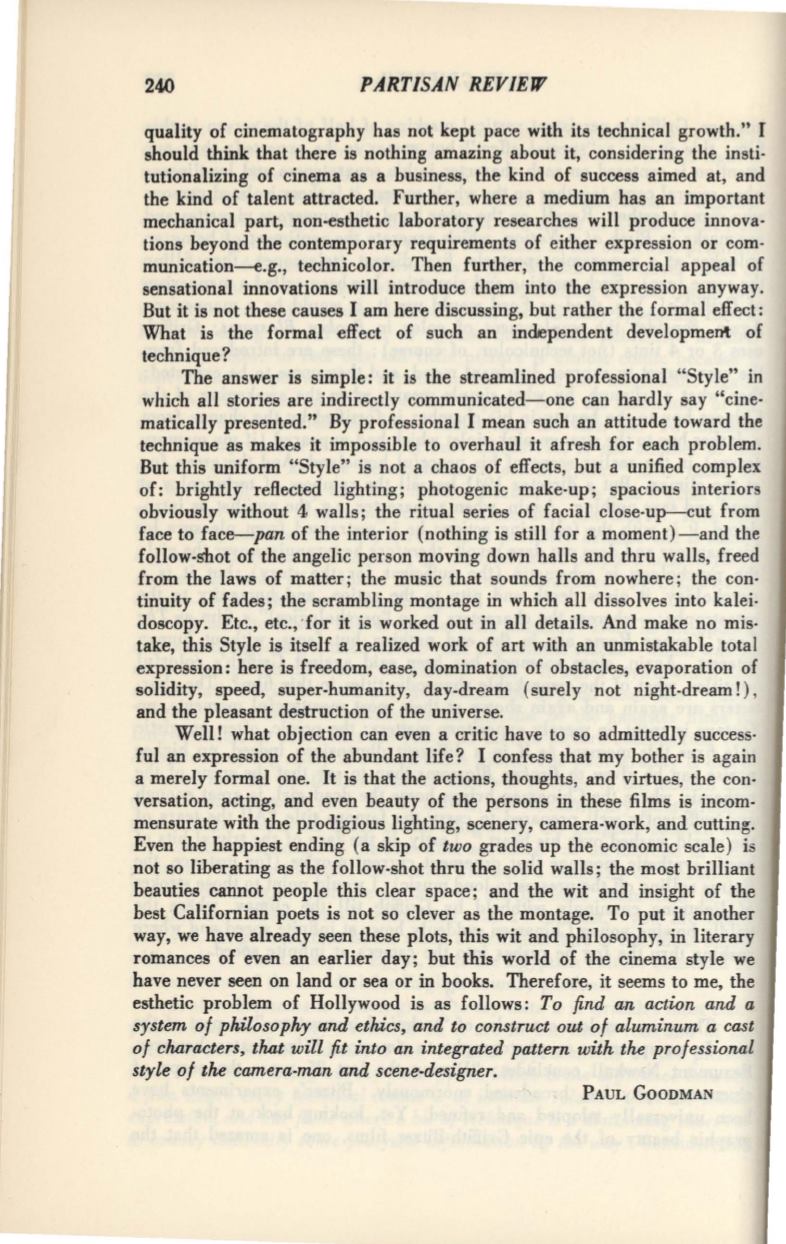
240
PARTISAN REVIEW
quality of cinematography has not kept pace with its technical growth." I
should think that there is nothing amazing about it, considering the insti·
tutionalizing of cinema as a business, the kind of success aimed at, and
the kind of talent attracted. Further, where a medium has an important
mechanical part, non-esthetic laboratory researches will produce innova·
tions beyond the contemporary requirements of either expression or com–
munication--e.g., technicolor. Then further, the commercial appeal of
sensational innovations will introduce them into the expression anyway.
But it is not these causes I am here discussing, but rather the formal effect:
What is the formal effect of such an indlependent development of
technique?
The answer is simple: it is the streamlined professional "Style" in
which all stories are indirectly communicated-one can hardly say "cine·
matically presented." By professional I mean such an attitude toward the
technique as makes it impossible to overhaul it afresh for each problem.
But this uniform "Style" is not a chaos of effects, hut a unified complex
of: brightly reflected lighting; photogenic make-up; spacious interiors
obviously without 4 walls; the ritual series of facial close-up--cut from
face to
face--pan
of the interior (nothing is still for a moment)-and the
follow-shot of the angelic person moving down halls and thru walls, freed
from the laws of matter; the music that sounds from nowhere; the con–
tinuity of fades; the scrambling montage in which all dissolves into kalei–
doscopy. Etc., etc., ·for it is worked out in all details. And make no mis–
take, this Style is itself a realized work of art with an unmistakable total
expression: here is freedom, ease, domination of obstacles, evaporation of
solidity, speed, super-humanity, day-dream (surely not night-dream! ),
and the pleasant destruction of the universe.
Well! what objection can even a critic have to so admittedly success–
ful an expression of the abundant life? I confess that my bother is again
a merely formal one. It is that the actions, thoughts, and virtues, the con–
versation, acting, and even beauty of the persons in these films is incom–
mensurate with the prodigious lighting, scenery, camera-work, and cutting.
Even the happiest ending (a skip of
two
grades up the economic scale) is
not so liberating as the follow-shot thru the solid walls; the most brilliant
beauties cannot people this clear space; and the wit and insight of the
best Californian poets is not so clever as the montage. To put it another
way, we have already seen these plots, this wit and philosophy, in literary
romances of even an earlier day; but this world of the cinema style we
have never seen on land or sea or in books. Therefore, it seems to me, the
esthetic problem of Hollywood is as follows:
To find an action and a
system of philosophy and ethics, and to construct out of aluminum a cast
of characters, that will fit into an integrated pattern with the professional
style of the camera-man and scene-designer.
PAUL GooDMAN


